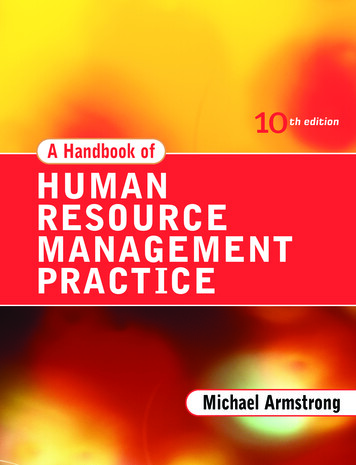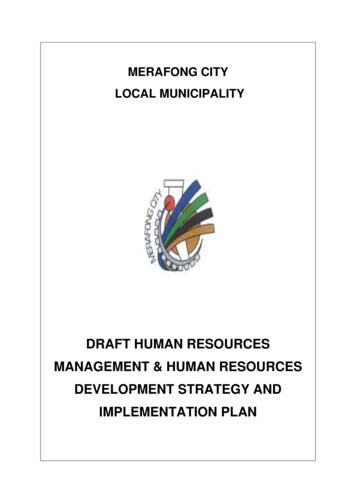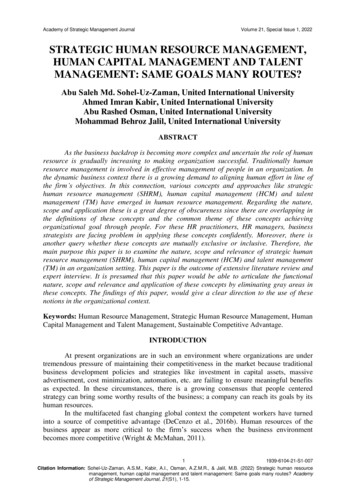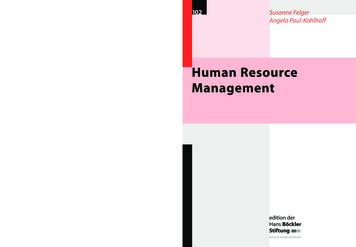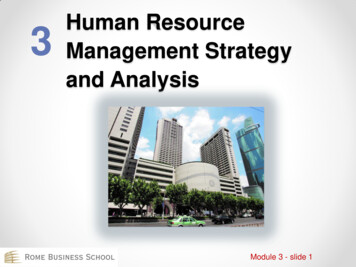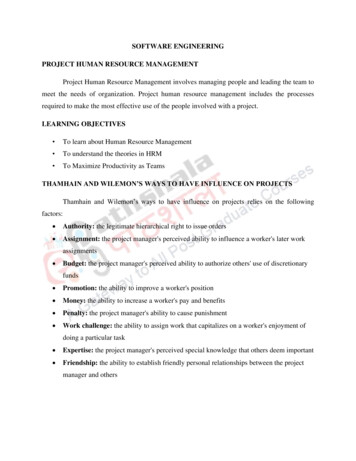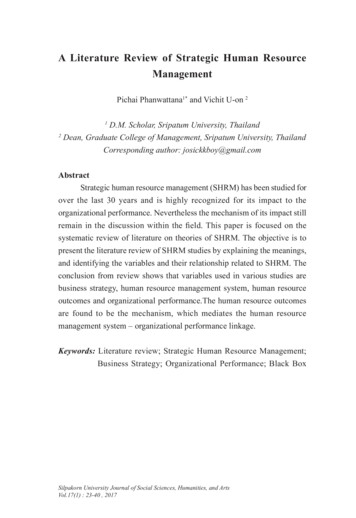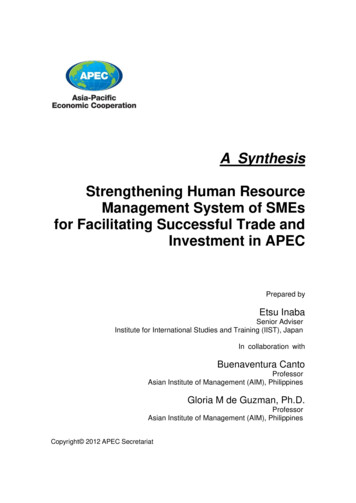
Transcription
A SynthesisStrengthening Human ResourceManagement System of SMEsfor Facilitating Successful Trade andInvestment in APECPrepared byEtsu InabaSenior AdviserInstitute for International Studies and Training (IIST), JapanIn collaboration withBuenaventura CantoProfessorAsian Institute of Management (AIM), PhilippinesGloria M de Guzman, Ph.D.ProfessorAsian Institute of Management (AIM), PhilippinesCopyright 2012 APEC Secretariat
2Strengthening HRM System of SMEsBACKGROUNDThe economic integration through trade and investment liberalisation in the Asia-PacificEconomic Cooperation (APEC) region presents tremendous opportunities forenterprises to become players in global supply chains or partners of foreign directinvestment (FDI).The APEC Human Resources Development Working Group - CapacityBuilding Network (HRDWG-CBN) has been implementing various projects in order toprepare enterprises to be effective players in this environment. In the project entitled“Intellectual Property Rights (IPR) Strategies for Emerging Enterprises – CapacityBuilding for Successful Entry to Global Supply Chain,” the importance of human capitalwas identified as one of the elements in recognizing, utilizing and protecting intellectualassets. The analysis and findings of the IPR project pointed to the strengthening ofhuman resource management (HRM) as a key success factor for the protection andenhancement of the intellectual value of enterprises.Effective HRM has always been high in the agenda of large multinational companieswhich invest time, energy and resources in ensuring that they continually attract,develop, motivate and retain the talent they need to support their continued growth andexpansion. Small and medium enterprises (SMEs), however, do not have suchresources at their disposal. Yet, SMEs constitute over 90% of enterprises in the APECregion. Despite their number, less than 10% of SMEs survive beyond the founder’slifetime. This low survival rate is often attributed to the inadequate HRM systems. FewSMEs have internal HRM systems and structures to cope with various challenges ofliberalisation. Strengthening their HRM systems is important to ensure a motivated,high-performing workforce that will, in turn, help the SMEs gain their partners’ trustwhen they enter the global supply chains. On the other hand, ineffective HRM can beviewed by the business partners as a possible source of enterprise vulnerability.Strengthening the human resource management systems of SMEs will thus directlycontribute to the facilitation of trade and investment in the region.With this background, the project entitled “Strengthening Human ResourceManagement System of SMEs for Facilitating Successful Trade and Investment inAPEC” was implemented for a year, starting in December 2011, under the auspices ofthe APEC HRDWG-CBN. It aimed to build the management capacity of SMEs througheffective HRM to enhance their competitiveness in the global market. It had thefollowing key objectives:1. To identify issues confronting SMEs in attracting, motivating, developing andretaining their people.2. To identify common elements and differences of good HRM practices amongAPEC members.3. To develop a framework and a prototype capacity building programme with casestudies for HRM in SMEs.Under the project, a total of 10 case studies were prepared involving eight APECeconomies. The cases illustrated real life issues and problems, and showcasedsuccessful HRM practices as well as commonalities and differences of HRM issues invarious APEC economies. A prototype capacity building programme was designed anda pilot seminar was conducted in September 2012 in Seoul, Korea to test theeffectiveness of the cases as learning materials and the methods of delivering them.Synthesis – 1
3Strengthening HRM System of SMEsThis synthesis paper summarizes the findings from the process of implementing theproject, including developing and teaching the cases by the resource persons as well assharing their knowledge and experiences with stakeholders.Moving forward, this paper identifies other APEC activities that would enhance thecontribution of effective human resource management in improving the performance ofSMEs.FRAMEWORK FOR STRATEGIC HRMA basic framework for Strategic Human Resource Management (S-HRM) wasdeveloped based on discussions during the initial meeting of the resource persons,analysis of the issues identified in the cases written for the project, and further refinedwith exchanges of ideas during the Pilot Seminar/Workshop held on 23 - 26 September2012 in Seoul, Korea. The purpose of the S-HRM Framework is to guide SMEs,especially those entering the global supply chain, on the steps to take in order toupgrade their HRM systems for long-term growth and profits.The S-HRM framework identifies both the process as well as the critical elementsimpacting on the performance of SMEs. More specifically, the framework involves: 1)identifying opportunities and challenges of economic liberalisation for the enterprise; 2)leveraging the enterprise’s own human resources, by clearly establishing its strategyand utilising their human resources effectively; 3) tapping innovation and technology forcompetitive advantage, and 4) shaping its organisational culture by introducing variousmanagement systems and practices in order that the values the management holds(which are a source of the SME’s competitive advantage), would be shared andimplemented effectively throughout the organisation. It is important that in each of thesesteps, the leader should articulate or clarify his or her unique vision, values andorientation in initiating and driving each of the steps in the framework (Figure 1).Figure 1: Strategic Human Resource Management Framework (S-HRM)Identifying Opportunitiesand Challenges underEconomic LiberalisationShapingOrganisationalCulture throughSystemsArticulatingLeader’sValues andOrientationTapping Innovation andTechnology forCompetitive AdvantageSynthesis – 2Leveraging HumanResources forStrategic Advantage
4Strengthening HRM System of SMEs1. Identifying Opportunities and Challenges of Economic LiberalisationThe liberalisation of the economy presents great opportunities for growth and expansion,if the enterprise sees and grabs them, making the best out of the situation. On the otherhand, some enterprises see greater threats as a result of liberalisation because ofimminent competition. Some companies, once they overcome difficulties posed bystringent international market requirements, will become stronger and be ahead of thecompetition. The leader and his senior management team will have to clearly identifyopportunities and challenges as the first step towards grabbing the opportunities andturning the situations around.2. Leveraging Human Resources for Strategic AdvantageWhen an enterprise clearly identifies opportunities and challenges, it needs to developstrategies that will give it a unique competitive advantage and position it to capture theopportunities and address any future challenges in the global market. As it developscompetitive strategies, the enterprise needs to understand and exploit the strengths ofthe current human resource complement, and at the same time tries to address anyshortcomings of its human resources and its management practices. This is all aboutbuilding internal capability for competitive advantage, which can be achieved byensuring that the enterprise has the right number of people with the right skills andmotivation for the right jobs. Such capability can be achieved through the recruitment,selection, development and motivation of the needed talent. The HRM policies andpractices instituted by the enterprise create this capability.The process of aligning HRM policies and practices with the enterprise’s strategies is inmost cases an iterative process. Changes in the current systems and practices maybring about unexpected results. When this happens, the leader and his managementteam have the responsibility to ensure that an alignment is achieved as they modify thesystems and practices.3. Tapping Innovation and Technology for Competitive AdvantageTo be able to compete and survive in the liberalised economic environment, it isimperative that the enterprise continuously innovates and advances its technologyahead of the competition. The innovation in this context is not only in the product andservice it provides, but also in its HRM practices. HRM must support and encourageinnovation and technological advancement in varying ways, depending on the situation.The leadership team usually paves the way and creates the environment for innovativeideas and technologies to be adopted and implemented.4. Shaping Organisational Culture through SystemsOrganisational culture can be a powerful driver of sustained competitive advantage forSMEs if it is aligned with their strategy. HRM systems can, and should be designed toshape an organisational culture that is aligned with the enterprise’s overall strategy.Hence, the leadership team, with effective use of HRM, should be able to create anorganisational culture so that members of the organisation would act accordinglywithout conscious efforts. Various HRM systems and practices are used to inculcatevalues among the members so that the organisational culture would be created andenforced.Synthesis – 3
5Strengthening HRM System of SMEs5. Articulating Leaders’ Values and OrientationThe leader’s vision, values, and orientation permeate all of the steps described in theS-HRM Framework. They drive the company’s openness to opportunities andchallenges, its capability to innovate and adopt technological advances, its willingnessto leverage its human resources for competitive advantage, and its readiness totransform its culture and HRM and management systems for continued growth andexpansion.Studies on successful entrepreneurial companies indicate a connection between theleader’s entrepreneurial orientation and the company’s performance. Entrepreneurialorientation has variously been defined to include autonomy, a willingness to innovateand take risks, a tendency to be aggressive toward competitors and to be proactive withregard to marketplace opportunities (Lumpkin and Des, 1966).The cases written for this project have leaders and their leadership team exhibit invarying degrees some of the characteristics described above.CASES DEVELOPEDTypes and UsesTen cases were developed under this project. The cases present real-life managementsituations and the various strategic issues and challenges faced by the entrepreneursand managers of SMEs. While a number of case types exist, the project focused on“good practice” illustration cases and “issue-based” or “decision-making” cases. Theproject team decided that the former type would be most useful in understanding the“know-what,” while the latter would be more appropriate for learning the “know-how.”The cases were written to serve as teaching materials for discussion in a capacitybuilding programme on “Strengthening Human Resources Management in SMEs forEconomic Liberalisation”. The cases developed and shown here have illustrations ofissues; some include successful management practices, and others have decisionmaking aspects. They can be used independently, or with other cases, to draw lessons,depending on the needs of the target audience. Table 1 presents a summary of the 10cases and their focus in the context of the S-HRM framework.Synthesis – 4
6Strengthening HRM System of SMEsTable 1: HRM Cases, By Type and Area of FocusEconomyCase TitlesOpportunities(O) andChallenges(C )ofEconomicLiberalisationLeveragingHR ngOrganisationalCulturethroughSystemsCase TypeDecisionMaking caseor Illustrationcase forDiscussiona)CanadaDataminewareC DecisionIndonesiaDharma SiagaC IllustrationIndonesiaO IllustrationJapanWisnu Karya PurtraInternat’lEdo-kirikoHanashyoO DecisionJapanKowa TechO DecisionKoreaDong YangMachinery IndustrialO IllustrationNewZealand2TouchO DecisionChineseTaipeiPasadenaInternationalO DecisionThailandGlobal PrecisionEngineeringC IllustrationO IllustrationViet NamViet-SoftwareInternationalNote a) O indicates that the management sees opportunities open to them as a result of liberalisation, whileC indicates the liberalisation presents bigger challenges for them to overcome.Note b) indicates primary focus, indicates secondary focus.Profiles and Highlights of the CasesSince the definition of SMEs in each of the APEC economies varies widely, the projectdecided to use a very simple guideline for the case subject, i.e., the number ofemployees should not be more than 300. The 10 cases represent various industriessuch as information technology, automobile-related products manufacturing, finance,food service, wood products as well as lifestyle and gift items. The sizes and histories ofthe small businesses range widely, from a nine-member family corporation with a65-year history to a fast growing six-year old company with 200 employees. (SeeExhibit 1 for profiles of the SMEs).The enterprises developed strategies, based on their own assessment of theopportunities and challenges they faced in the light of economic liberalisation. Someviewed economic liberalisation as great opportunities and tried to take advantage ofthem, while others view them as a source of greater challenges to be overcome with theSynthesis – 5
7Strengthening HRM System of SMEsright business strategy. In either case, the SME leaders took a proactive approach to thesituations that confronted their businesses. (See Exhibit 2 for opportunities andchallenges.)Although most of the cases illustrate recruiting, developing, motivating and retainingnecessary talents as the main HRM issues, the means of addressing the issues varieddepending on the situation. Since SMEs are normally not the preferred employmentchoice for high achievers, creative approaches have been employed by some of theSMEs to attract them. Many offered training opportunities or even lowered the entrylevel qualifications. Establishing a “brand” not only in a product market, but also in therecruitment market was also effective.More effective training methods and schemes as well as varieties of performanceevaluation systems were also highlighted in the cases. (See Exhibit 3 for HRM Issues).As the SMEs entered into more competitive environments, more formal performancebased evaluation systems were adopted. Since the entrepreneurs or leaders of theorganisations had a major influence on the strategy and management practices of theSMEs, they also revealed their personal values. (See Exhibit 4 for Profiles of Leaders.)Presented below are brief abstracts of the cases developed under the project.DATAMINEWARE (Canada)Datamineware (name and situations disguised) was in the information technologyindustry in North America. It developed and updated software for existing informationsystem in manufacturing companies, incorporating various new elements andfunctionalities in the existing software. The speed with which Datamineware updatedsoftware for customers’ changing needs was considered its competitive advantage. Theentrepreneur, John Denning, who was knowledgeable of customer requirements, wascapable of orchestrating the development process with the help of software developers.Competent software developers were in demand almost anywhere in the world, thusthey tended to be mobile in pursuit of different and challenging experiences.As the business expanded, John decided to have a Chief Information Officer (CIO) tooversee the development process. John, together with the new CIO, introduced anumber of changes, including a formal performance evaluation system and newsoftware development language so that the schedules would be followed. Timelydelivery became a primary concern, sacrificing the ability to respond to customercomplaints. Although the changes were made to address immediate issues, thosechanges in work procedure and evaluation appeared to create new problems for thecompany.Dharma Siaga (Indonesia)Dharma Siaga was a small cooperative, trying to serve its members composed primarilyof owners of micro-businesses serving foreign tourists. Because of the liberalisation ofthe economy, including the service sector, the banking industry had becomeincreasingly competitive. The management of Dharma Siaga believed that the only wayfor them to survive and grow was to serve the existing customers better and increasetheir transactions with the cooperative by catering to their varied needs. To achieve thisSynthesis – 6
8Strengthening HRM System of SMEsgoal, Dharma Siaga needed to strengthen their marketing staff who would deal directlywith the customers. In the past, Dharma had difficulty in attracting people to work forthem, since the youth did not favor SMEs like Dharma as sources of employment.Dharma Siaga shifted their recruitment requirements to attract those with lowereducational qualifications and offered training programmes to get them interested towork for Dharma. The cooperative also instituted performance based evaluation system,rather than traditional seniority based system, and provided high performing employeesan opportunity to obtain higher education.Wisnu Karya Putra International (WKPI - Indonesia)The case on WKPI, a producer/exporter of wood products and furniture in Bali,illustrates how the company entered the international supply chain. New stringentinternational requirements for environment protection and sustainability requiredexporters to follow strict standards throughout the supply chain. While WKPI was able tosecure the government certification, it was necessary to ensure that other parties in itssupply chain, including material suppliers, followed the standards and prepared thenecessary documentation. It required discipline to follow such standards, especiallybecause instituting discipline in a traditionally “laid-back” Balinese culture requiredcreativity.Wayan Diana, entrepreneur, used his network in the government and internationalNGOs to help educate the other players in the industry through participation in theincubation centre programme that helped disseminate know-hows on followinginternational requirements.EdokirikoHanashyo (Japan)EdokirikoHanashyo was a small family-owned company manufacturing traditional cutglass products (Edo Kiriko). The company had been in existence over three generations.The second generation owner undertook initiatives to transform the company frombeing an OEM manufacturer to having its own brand and unique designs and process.The company established its reputation as the source of quality traditional Japanesecraft products often given as gifts to state guests.The founder’s son and third generation owner, Takayuki, understood that it would be hisrole to expand sales channels overseas for growth and for the sake of futuregenerations. However, he was concerned about the lack of skilled craftsmen needed toserve an expanded market. He also realized the constraints and limitations of Hanashyoas a small, family-owned enterprise in developing and retaining the right number ofcraftsmen with the right skills. He started to consider how much and how fast theirbusiness could be expanded and what would be the priority issues in term of their HRMto support the company’s growth and expansion.Synthesis – 7
9Strengthening HRM System of SMEsKOWA TECH (Japan)When Yuji Oguri, the second generation owner, took over Kowa from his father, thecompany was a subcontractor of large automakers for their specialty vehiclerequirements. The company was also in deep financial trouble and was burdened withan old and highly paid workforce. Yuji instituted various changes, including changing thecompany name to Kowa Tech, to signify his emphasis on technology. After painstakingefforts to convince the older workforce (over 70 years old) to retire, he started to recruityounger engineers with college degrees. Initially it was not easy for Kowa Tech to attractyoung graduates. Through the help of engineering school professors, Yuji eventually gotyounger graduates to work for him, promising challenging and creative work which acompany of Kowa Tech’s size was in a better position to offer. Yuji also instituted moreprofessional management systems, including clear cost accounting and exploration ofnew markets.The major turning point for the company came when they were requested to producethe first domestically developed amphibious vehicle. Despite all odds and objections bythe engineers, Yuji decided to take on the challenge. Using his university and otherconnections, he was able to solicit collaborators, who not only provided technicalsupport, but also made computer simulation facilities available to him. After two years ofexperiments and clearing cumbersome legal requirements, Kowa Tech was able tosuccessfully develop the first amphibious vehicle in Japan. During the developmentprocess, Yuji introduced leadership development and team building programmes,through which people from different sections of the company started to work effectively.Sharing of vision and performance measures also contributed to higher motivation ofthe staff.Having fully internalised the production technologies of amphibious vehicles with its 5thunit, Yuji was considering an option to go international and/or develop new amphibiousmotor cycles in the near future.Dong Yang Machinery Industrial Co., Ltd (Korea)The case highlights various support programmes intended to strengthen SMEs to bestable employers, which were offered by the government sponsored programmethrough HRD Korea. The owner of Dong Yang had managed to provide continuousemployment to their employees even during the severe economic conditions, by sharingwork among them. As a result of this gesture, employee loyalty to Dong Yang wasenhanced. To further strengthen its management capability, Dong Yang sought thesupport of HRD Korea which provided consultancy services in productivity improvement,building a learning organisation and structured on-the-job training.Productivity and performance, as well as employees’ morale, went up substantially,making the company an even more profitable and stable employer. Dong Yang’sachievement as a model employer was highly publicized, raising awareness amongother SMEs of the potential benefits of HRD Korea’s services.Synthesis – 8
10Strengthening HRM System of SMEs2Touch (New Zealand)The case presents the dilemma of Pablo Garcia, a New Zealand entrepreneur, who hadto take the lead in two sister organisations in New Zealand, plus one division in Australia.The case illustrates the challenges he faced from the early days back in 1998, when heenvisioned the development of a product to assist the interactive learning and teachingprocess. Since 2Touch adopted a “push” marketing strategy, which required thecompany to determine unrecognised needs of the customer and offered products whichaddressed such needs, the company had to develop a culture of creativity andinnovation. With an R&D team of diverse backgrounds and culture, 2Touch was able toexploit their employees’ intrinsic motivation to be creative. The company added a new“goal metrics” performance evaluation system, where employees’ own goals weremeasured against company goals.While 2Touch had been successful so far, the management was considering expandingits business outside New Zealand and Australia. Pablo was wondering if the sameapproaches would work in a different environment, as he moved towards realising thepossibilities for international expansion.Pasadena International Group (Chinese Taipei)Mr Shiu Jeng-Ji was the founder of an OEM of consumer electronic products, withoperations overseas. He established Pasadena International Group by providing itscustomers unique value in its products and customer service that differentiated thecompany from its competitors. Pasadena had become a well known bakery andrestaurant for the past ten years. This case illustrates the key role that human resourcemanagement plays in determining the survival, effectiveness and competitiveness ofSMEs like Pasadena in the foodservice business in Chinese Taipei.The case further highlights how effective HRM practices support SME business goalsand objectives in the foodservice sector including attracting potential employees(recruiting), choosing employees (selection), teaching employees how to perform theirjobs well (training), rewarding employees (compensation), and creating a positive workenvironment (good employee relations). It also provides an example of how an SME likePasadena links corporate social responsibility to its brand.Pasadena has established a clear and trustworthy image to their customer, starting fromthe introduction of some concepts and products which promoted the importance ofenvironmental protection up to the company’s community involvement.Global Precision Engineering (Thailand)In line with the government policy to develop the local mould and die industry, GlobalPrecision Engineering (GPE) was established under the Thai-German Institute’sindustry incubation project. GPE upgraded its capabilities to manufacture mould for autoand other industries. However, being a small company, it faced difficulties in attracting,training and retaining most of its workforce. In order to address the issue of employeeretention, GPE started to recruit employees with lower educational level qualification,offered monthly salary rather than daily wages and showed clear career paths usingSynthesis – 9
11Strengthening HRM System of SMEsindustry standard qualifications. In addition, it introduced the bonus system to reflect theworkers’ performance. All of these new measures were made with an overall thrust totreat the workforce as family members.While GPE effectively used various support mechanisms under the Mould and DieCluster of Thailand, including the use of a common facility, machine time sharing andjoint training, more creative efforts may have to be introduced.VietSoftware International Inc. (Viet Nam)VietSoftware International Inc. (VSII) operated as a software outsourcing serviceprovider with offshore dedicated centers for clients in Europe, Japan and the UnitedStates. The human resource (HR) challenge that it continued to face included the highstaff turnover rate, strong competition for qualified and talented staff, qualification ofsoftware developers, and the need to introduce an advanced HR system that worked inthe Vietnamese context. Lack of professional interpersonal and communication skills ofthe staff resulted in lower work productivity.The constraints also deterred VSII from scaling up to compete with other companiesthat were strong at information technology or business process outsourcing (ITO/BPO).In addition, HR constraints in the Vietnamese labor market, especially in the softwareindustry, were serious hurdles that VSII had to overcome in order to improve itscompetitiveness and productivity, and its ability to meet the increasingly sophisticatedneeds of international customers. They also slowed down the integration of VSII into theglobal supply chain and its efforts to increase revenue.PILOT SEMINARAfter the cases had been written, a 2-day pilot seminar programme entitled “StrategicHuman Resource Management for SME: Winning in the Global Economy” wasorganized, using the S-HRM framework. The seminar was held on 24-25 September2012 in Seoul, Korea with a total of 27 participants, including 12 APEC resourcepersons. The local participants included SME owners, representatives of largecompanies with SMEs in their supply chain, SME management development institutionsand government agencies. The seminar was delivered with all the case authorspresenting their cases under the guidance of Professor Buenaventura Canto and MsEtsu Inaba.The purpose, process and benefits of the pilot seminar were as follows:Learning Goals & ObjectivesIn line with APEC’s goals, the pilot seminar was designed to provide a number ofcompetencies or learning outcomes among the participants. At the close of the seminar,it was expected that the participants would be able to:Synthesis – 10
12Strengthening HRM System of SMEs1. Identify and understand the strategic importance of HRM systems and practicesto organisational performance, growth and expansion in global markets.2. Appreciate common issues and different approaches to addressing HRM issuesin SMEs.3. Identify key success factors for developing appropriate and innovative HRMsystems and practices that will facilitate SMEs’ participation in the global supplychain.4. Apply the lessons learned to their own settings.Seminar Programme & MethodologiesThe pilot seminar was designed using the basic framework developed for the projectconsisting of the following components: 1) identifying opportunities and challenges ofeconomic liberalisation for the company, 2) leveraging human resources, by clearlyestablishing a unique competitive business strategy and utilising human resourceseffectively, 3) introducing innovation and technology to advance competitive strengthfurther, and 4) shaping organisational culture by introducing various managementsystems and practices. The seminar took the participants on a journey through thevarious areas of knowledge and skills of human resource management in SMEs in“building block” fashion, albeit very rapidly, given the time constraints the group had towork with (See Exhibit 5).Due to the fact that only a few of the participants understood English, cases werepresented on the seminar day, with the assumption that only a few of them would beable to read them ahead of the seminar. Thus the case discussion was somewhatlimited in terms of time. All 10 cases developed for the project were presented by thecase authors, with time allocated for discussion in small groups as well as by the entireclass.Feedback from Participants and Resource PersonsThe participants repo
With this background, the project entitled "Strengthening Human Resource Management System of SMEs for Facilitating Successful Trade and Investment in APEC" was implemented for a year, starting in December 2011, under the auspices of the APEC HRDWG-CBN. It aimed to build the management capacity of SMEs through


